Systematic Review Protocol: Maternal Mortality in Ogun State, Nigeria
VerifiedAdded on 2023/04/19
|26
|7198
|238
Report
AI Summary
This document is a systematic review protocol focusing on the determinants of high maternal mortality rates in Ogun State, Nigeria. It begins with an introduction highlighting the global issue of maternal mortality and its prevalence in developing nations. The research aims to investigate factors affecting maternal mortality in Ogun State, addressing the increasing rates in Nigeria and globally. The protocol outlines the background, objectives, and methods of the review, including the search strategy, study selection criteria, quality assessment, and data synthesis. It references the WHO's statistics on maternal deaths and discusses the healthcare system challenges in Ogun State. The research question centers on identifying determinants of maternal mortality among women of childbearing age (15-49 years). The protocol emphasizes a systematic review of literature to examine correlations between variables and identify knowledge gaps, aiming to contribute to tackling maternal mortality through deeper understanding and improved healthcare qualities.
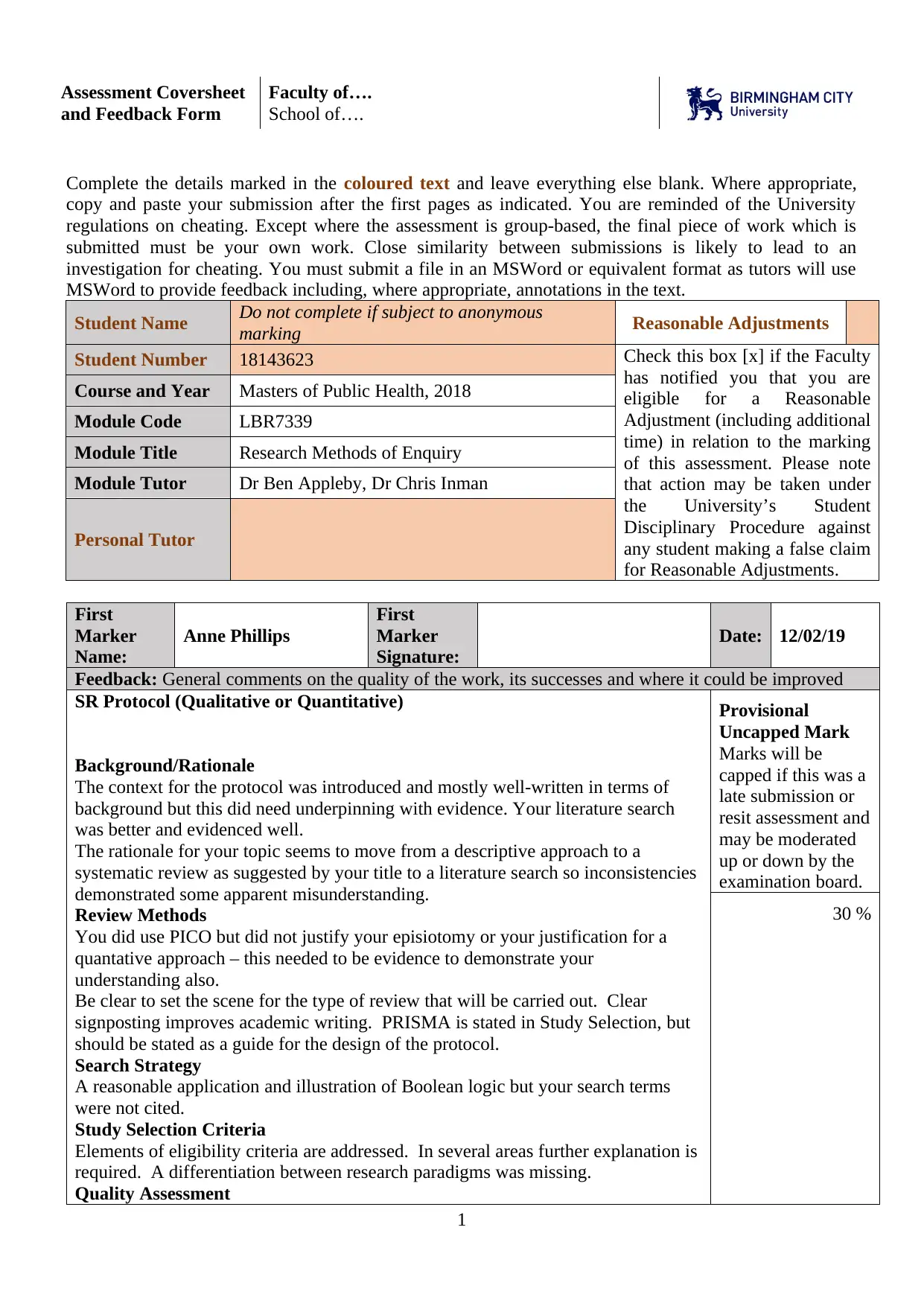
Assessment Coversheet
and Feedback Form
Faculty of….
School of….
Complete the details marked in the coloured text and leave everything else blank. Where appropriate,
copy and paste your submission after the first pages as indicated. You are reminded of the University
regulations on cheating. Except where the assessment is group-based, the final piece of work which is
submitted must be your own work. Close similarity between submissions is likely to lead to an
investigation for cheating. You must submit a file in an MSWord or equivalent format as tutors will use
MSWord to provide feedback including, where appropriate, annotations in the text.
Student Name Do not complete if subject to anonymous
marking Reasonable Adjustments
Student Number 18143623 Check this box [x] if the Faculty
has notified you that you are
eligible for a Reasonable
Adjustment (including additional
time) in relation to the marking
of this assessment. Please note
that action may be taken under
the University’s Student
Disciplinary Procedure against
any student making a false claim
for Reasonable Adjustments.
Course and Year Masters of Public Health, 2018
Module Code LBR7339
Module Title Research Methods of Enquiry
Module Tutor Dr Ben Appleby, Dr Chris Inman
Personal Tutor
First
Marker
Name:
Anne Phillips
First
Marker
Signature:
Date: 12/02/19
Feedback: General comments on the quality of the work, its successes and where it could be improved
SR Protocol (Qualitative or Quantitative)
Background/Rationale
The context for the protocol was introduced and mostly well-written in terms of
background but this did need underpinning with evidence. Your literature search
was better and evidenced well.
The rationale for your topic seems to move from a descriptive approach to a
systematic review as suggested by your title to a literature search so inconsistencies
demonstrated some apparent misunderstanding.
Review Methods
You did use PICO but did not justify your episiotomy or your justification for a
quantative approach – this needed to be evidence to demonstrate your
understanding also.
Be clear to set the scene for the type of review that will be carried out. Clear
signposting improves academic writing. PRISMA is stated in Study Selection, but
should be stated as a guide for the design of the protocol.
Search Strategy
A reasonable application and illustration of Boolean logic but your search terms
were not cited.
Study Selection Criteria
Elements of eligibility criteria are addressed. In several areas further explanation is
required. A differentiation between research paradigms was missing.
Quality Assessment
Provisional
Uncapped Mark
Marks will be
capped if this was a
late submission or
resit assessment and
may be moderated
up or down by the
examination board.
30 %
1
and Feedback Form
Faculty of….
School of….
Complete the details marked in the coloured text and leave everything else blank. Where appropriate,
copy and paste your submission after the first pages as indicated. You are reminded of the University
regulations on cheating. Except where the assessment is group-based, the final piece of work which is
submitted must be your own work. Close similarity between submissions is likely to lead to an
investigation for cheating. You must submit a file in an MSWord or equivalent format as tutors will use
MSWord to provide feedback including, where appropriate, annotations in the text.
Student Name Do not complete if subject to anonymous
marking Reasonable Adjustments
Student Number 18143623 Check this box [x] if the Faculty
has notified you that you are
eligible for a Reasonable
Adjustment (including additional
time) in relation to the marking
of this assessment. Please note
that action may be taken under
the University’s Student
Disciplinary Procedure against
any student making a false claim
for Reasonable Adjustments.
Course and Year Masters of Public Health, 2018
Module Code LBR7339
Module Title Research Methods of Enquiry
Module Tutor Dr Ben Appleby, Dr Chris Inman
Personal Tutor
First
Marker
Name:
Anne Phillips
First
Marker
Signature:
Date: 12/02/19
Feedback: General comments on the quality of the work, its successes and where it could be improved
SR Protocol (Qualitative or Quantitative)
Background/Rationale
The context for the protocol was introduced and mostly well-written in terms of
background but this did need underpinning with evidence. Your literature search
was better and evidenced well.
The rationale for your topic seems to move from a descriptive approach to a
systematic review as suggested by your title to a literature search so inconsistencies
demonstrated some apparent misunderstanding.
Review Methods
You did use PICO but did not justify your episiotomy or your justification for a
quantative approach – this needed to be evidence to demonstrate your
understanding also.
Be clear to set the scene for the type of review that will be carried out. Clear
signposting improves academic writing. PRISMA is stated in Study Selection, but
should be stated as a guide for the design of the protocol.
Search Strategy
A reasonable application and illustration of Boolean logic but your search terms
were not cited.
Study Selection Criteria
Elements of eligibility criteria are addressed. In several areas further explanation is
required. A differentiation between research paradigms was missing.
Quality Assessment
Provisional
Uncapped Mark
Marks will be
capped if this was a
late submission or
resit assessment and
may be moderated
up or down by the
examination board.
30 %
1
Paraphrase This Document
Need a fresh take? Get an instant paraphrase of this document with our AI Paraphraser
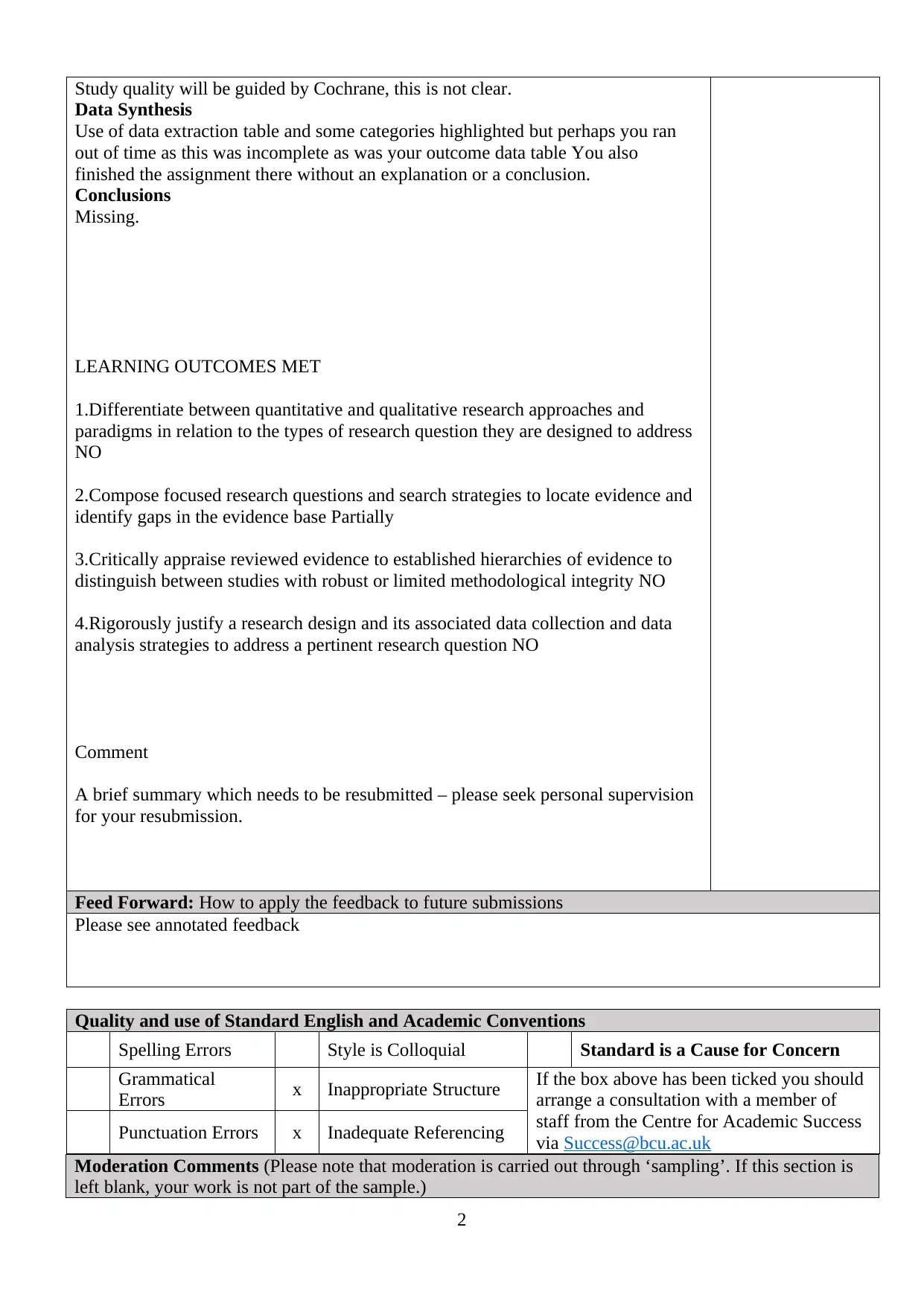
Study quality will be guided by Cochrane, this is not clear.
Data Synthesis
Use of data extraction table and some categories highlighted but perhaps you ran
out of time as this was incomplete as was your outcome data table You also
finished the assignment there without an explanation or a conclusion.
Conclusions
Missing.
LEARNING OUTCOMES MET
1.Differentiate between quantitative and qualitative research approaches and
paradigms in relation to the types of research question they are designed to address
NO
2.Compose focused research questions and search strategies to locate evidence and
identify gaps in the evidence base Partially
3.Critically appraise reviewed evidence to established hierarchies of evidence to
distinguish between studies with robust or limited methodological integrity NO
4.Rigorously justify a research design and its associated data collection and data
analysis strategies to address a pertinent research question NO
Comment
A brief summary which needs to be resubmitted – please seek personal supervision
for your resubmission.
Feed Forward: How to apply the feedback to future submissions
Please see annotated feedback
Quality and use of Standard English and Academic Conventions
Spelling Errors Style is Colloquial Standard is a Cause for Concern
Grammatical
Errors x Inappropriate Structure If the box above has been ticked you should
arrange a consultation with a member of
staff from the Centre for Academic Success
via Success@bcu.ac.uk
Punctuation Errors x Inadequate Referencing
Moderation Comments (Please note that moderation is carried out through ‘sampling’. If this section is
left blank, your work is not part of the sample.)
2
Data Synthesis
Use of data extraction table and some categories highlighted but perhaps you ran
out of time as this was incomplete as was your outcome data table You also
finished the assignment there without an explanation or a conclusion.
Conclusions
Missing.
LEARNING OUTCOMES MET
1.Differentiate between quantitative and qualitative research approaches and
paradigms in relation to the types of research question they are designed to address
NO
2.Compose focused research questions and search strategies to locate evidence and
identify gaps in the evidence base Partially
3.Critically appraise reviewed evidence to established hierarchies of evidence to
distinguish between studies with robust or limited methodological integrity NO
4.Rigorously justify a research design and its associated data collection and data
analysis strategies to address a pertinent research question NO
Comment
A brief summary which needs to be resubmitted – please seek personal supervision
for your resubmission.
Feed Forward: How to apply the feedback to future submissions
Please see annotated feedback
Quality and use of Standard English and Academic Conventions
Spelling Errors Style is Colloquial Standard is a Cause for Concern
Grammatical
Errors x Inappropriate Structure If the box above has been ticked you should
arrange a consultation with a member of
staff from the Centre for Academic Success
via Success@bcu.ac.uk
Punctuation Errors x Inadequate Referencing
Moderation Comments (Please note that moderation is carried out through ‘sampling’. If this section is
left blank, your work is not part of the sample.)
2
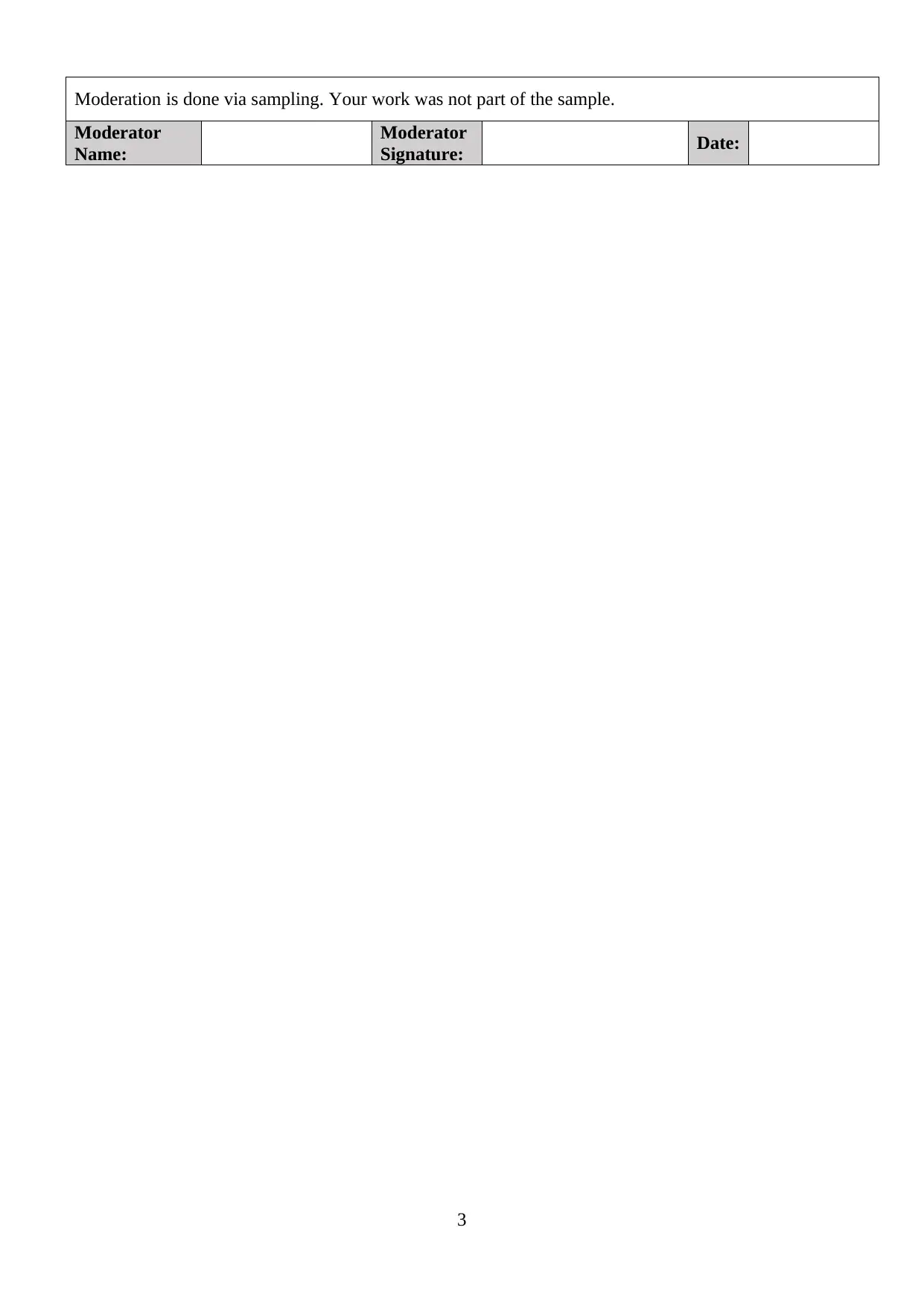
Moderation is done via sampling. Your work was not part of the sample.
Moderator
Name:
Moderator
Signature: Date:
3
Moderator
Name:
Moderator
Signature: Date:
3
⊘ This is a preview!⊘
Do you want full access?
Subscribe today to unlock all pages.

Trusted by 1+ million students worldwide
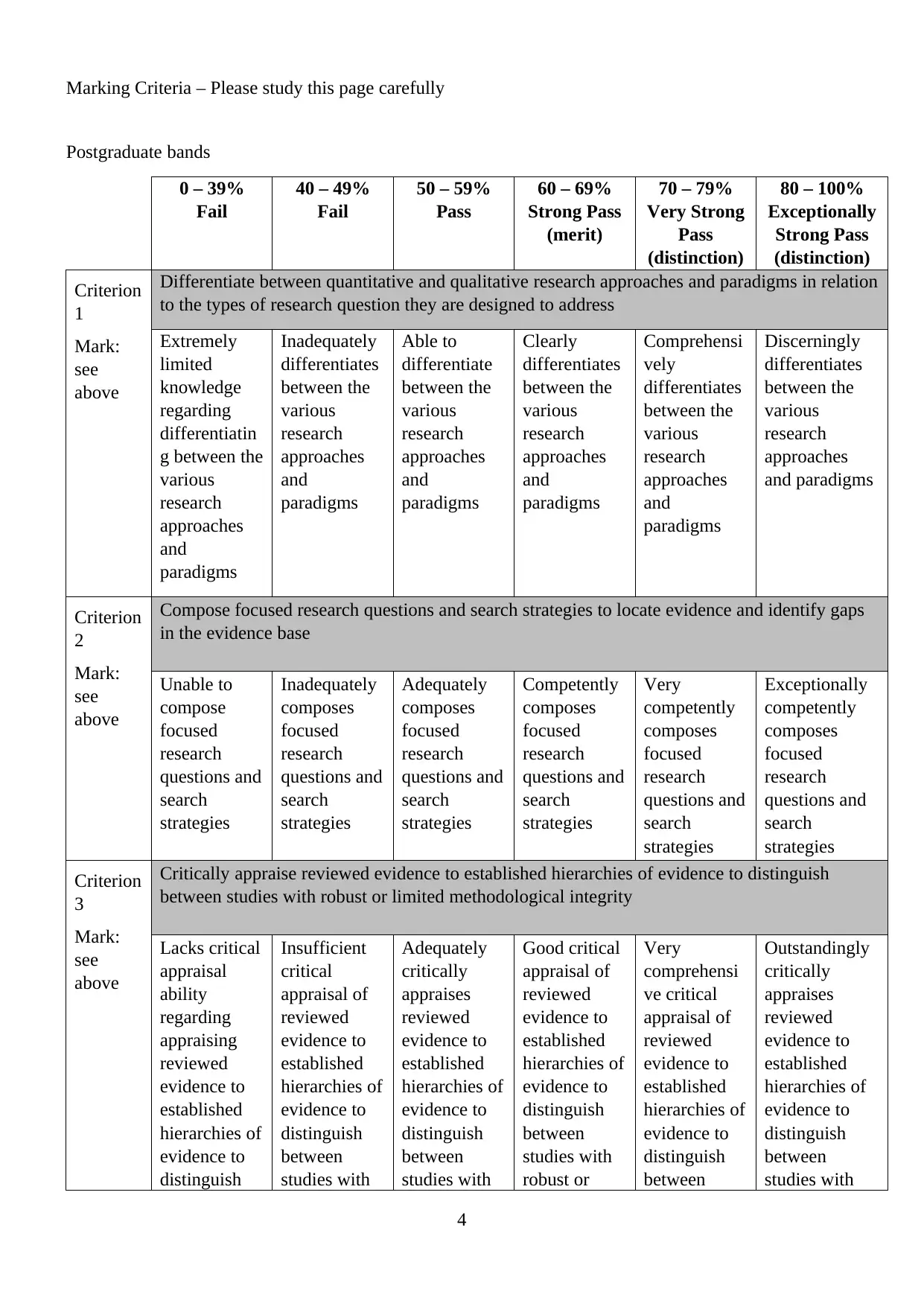
Marking Criteria – Please study this page carefully
Postgraduate bands
0 – 39%
Fail
40 – 49%
Fail
50 – 59%
Pass
60 – 69%
Strong Pass
(merit)
70 – 79%
Very Strong
Pass
(distinction)
80 – 100%
Exceptionally
Strong Pass
(distinction)
Criterion
1
Mark:
see
above
Differentiate between quantitative and qualitative research approaches and paradigms in relation
to the types of research question they are designed to address
Extremely
limited
knowledge
regarding
differentiatin
g between the
various
research
approaches
and
paradigms
Inadequately
differentiates
between the
various
research
approaches
and
paradigms
Able to
differentiate
between the
various
research
approaches
and
paradigms
Clearly
differentiates
between the
various
research
approaches
and
paradigms
Comprehensi
vely
differentiates
between the
various
research
approaches
and
paradigms
Discerningly
differentiates
between the
various
research
approaches
and paradigms
Criterion
2
Mark:
see
above
Compose focused research questions and search strategies to locate evidence and identify gaps
in the evidence base
Unable to
compose
focused
research
questions and
search
strategies
Inadequately
composes
focused
research
questions and
search
strategies
Adequately
composes
focused
research
questions and
search
strategies
Competently
composes
focused
research
questions and
search
strategies
Very
competently
composes
focused
research
questions and
search
strategies
Exceptionally
competently
composes
focused
research
questions and
search
strategies
Criterion
3
Mark:
see
above
Critically appraise reviewed evidence to established hierarchies of evidence to distinguish
between studies with robust or limited methodological integrity
Lacks critical
appraisal
ability
regarding
appraising
reviewed
evidence to
established
hierarchies of
evidence to
distinguish
Insufficient
critical
appraisal of
reviewed
evidence to
established
hierarchies of
evidence to
distinguish
between
studies with
Adequately
critically
appraises
reviewed
evidence to
established
hierarchies of
evidence to
distinguish
between
studies with
Good critical
appraisal of
reviewed
evidence to
established
hierarchies of
evidence to
distinguish
between
studies with
robust or
Very
comprehensi
ve critical
appraisal of
reviewed
evidence to
established
hierarchies of
evidence to
distinguish
between
Outstandingly
critically
appraises
reviewed
evidence to
established
hierarchies of
evidence to
distinguish
between
studies with
4
Postgraduate bands
0 – 39%
Fail
40 – 49%
Fail
50 – 59%
Pass
60 – 69%
Strong Pass
(merit)
70 – 79%
Very Strong
Pass
(distinction)
80 – 100%
Exceptionally
Strong Pass
(distinction)
Criterion
1
Mark:
see
above
Differentiate between quantitative and qualitative research approaches and paradigms in relation
to the types of research question they are designed to address
Extremely
limited
knowledge
regarding
differentiatin
g between the
various
research
approaches
and
paradigms
Inadequately
differentiates
between the
various
research
approaches
and
paradigms
Able to
differentiate
between the
various
research
approaches
and
paradigms
Clearly
differentiates
between the
various
research
approaches
and
paradigms
Comprehensi
vely
differentiates
between the
various
research
approaches
and
paradigms
Discerningly
differentiates
between the
various
research
approaches
and paradigms
Criterion
2
Mark:
see
above
Compose focused research questions and search strategies to locate evidence and identify gaps
in the evidence base
Unable to
compose
focused
research
questions and
search
strategies
Inadequately
composes
focused
research
questions and
search
strategies
Adequately
composes
focused
research
questions and
search
strategies
Competently
composes
focused
research
questions and
search
strategies
Very
competently
composes
focused
research
questions and
search
strategies
Exceptionally
competently
composes
focused
research
questions and
search
strategies
Criterion
3
Mark:
see
above
Critically appraise reviewed evidence to established hierarchies of evidence to distinguish
between studies with robust or limited methodological integrity
Lacks critical
appraisal
ability
regarding
appraising
reviewed
evidence to
established
hierarchies of
evidence to
distinguish
Insufficient
critical
appraisal of
reviewed
evidence to
established
hierarchies of
evidence to
distinguish
between
studies with
Adequately
critically
appraises
reviewed
evidence to
established
hierarchies of
evidence to
distinguish
between
studies with
Good critical
appraisal of
reviewed
evidence to
established
hierarchies of
evidence to
distinguish
between
studies with
robust or
Very
comprehensi
ve critical
appraisal of
reviewed
evidence to
established
hierarchies of
evidence to
distinguish
between
Outstandingly
critically
appraises
reviewed
evidence to
established
hierarchies of
evidence to
distinguish
between
studies with
4
Paraphrase This Document
Need a fresh take? Get an instant paraphrase of this document with our AI Paraphraser
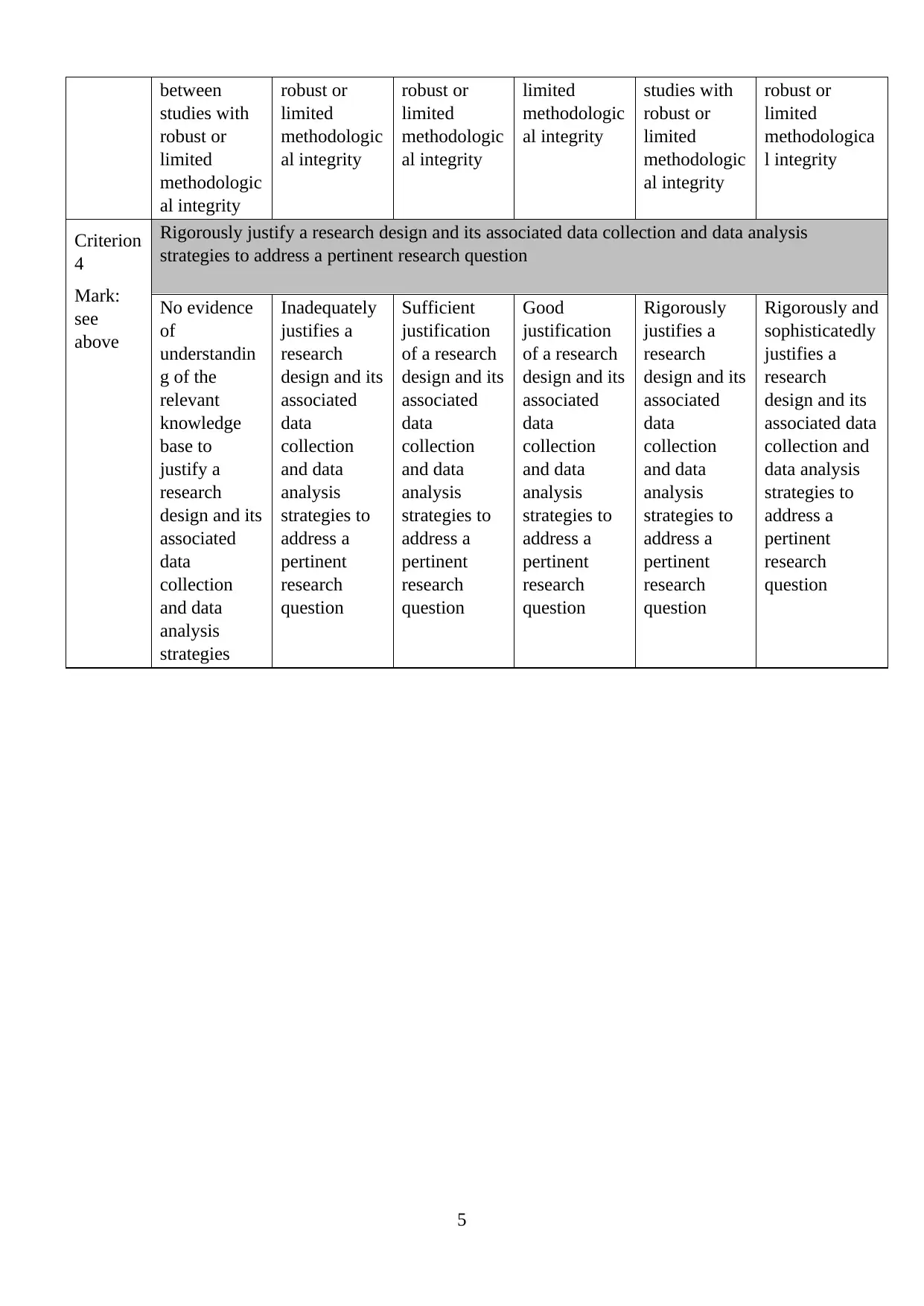
between
studies with
robust or
limited
methodologic
al integrity
robust or
limited
methodologic
al integrity
robust or
limited
methodologic
al integrity
limited
methodologic
al integrity
studies with
robust or
limited
methodologic
al integrity
robust or
limited
methodologica
l integrity
Criterion
4
Mark:
see
above
Rigorously justify a research design and its associated data collection and data analysis
strategies to address a pertinent research question
No evidence
of
understandin
g of the
relevant
knowledge
base to
justify a
research
design and its
associated
data
collection
and data
analysis
strategies
Inadequately
justifies a
research
design and its
associated
data
collection
and data
analysis
strategies to
address a
pertinent
research
question
Sufficient
justification
of a research
design and its
associated
data
collection
and data
analysis
strategies to
address a
pertinent
research
question
Good
justification
of a research
design and its
associated
data
collection
and data
analysis
strategies to
address a
pertinent
research
question
Rigorously
justifies a
research
design and its
associated
data
collection
and data
analysis
strategies to
address a
pertinent
research
question
Rigorously and
sophisticatedly
justifies a
research
design and its
associated data
collection and
data analysis
strategies to
address a
pertinent
research
question
5
studies with
robust or
limited
methodologic
al integrity
robust or
limited
methodologic
al integrity
robust or
limited
methodologic
al integrity
limited
methodologic
al integrity
studies with
robust or
limited
methodologic
al integrity
robust or
limited
methodologica
l integrity
Criterion
4
Mark:
see
above
Rigorously justify a research design and its associated data collection and data analysis
strategies to address a pertinent research question
No evidence
of
understandin
g of the
relevant
knowledge
base to
justify a
research
design and its
associated
data
collection
and data
analysis
strategies
Inadequately
justifies a
research
design and its
associated
data
collection
and data
analysis
strategies to
address a
pertinent
research
question
Sufficient
justification
of a research
design and its
associated
data
collection
and data
analysis
strategies to
address a
pertinent
research
question
Good
justification
of a research
design and its
associated
data
collection
and data
analysis
strategies to
address a
pertinent
research
question
Rigorously
justifies a
research
design and its
associated
data
collection
and data
analysis
strategies to
address a
pertinent
research
question
Rigorously and
sophisticatedly
justifies a
research
design and its
associated data
collection and
data analysis
strategies to
address a
pertinent
research
question
5

6
⊘ This is a preview!⊘
Do you want full access?
Subscribe today to unlock all pages.

Trusted by 1+ million students worldwide
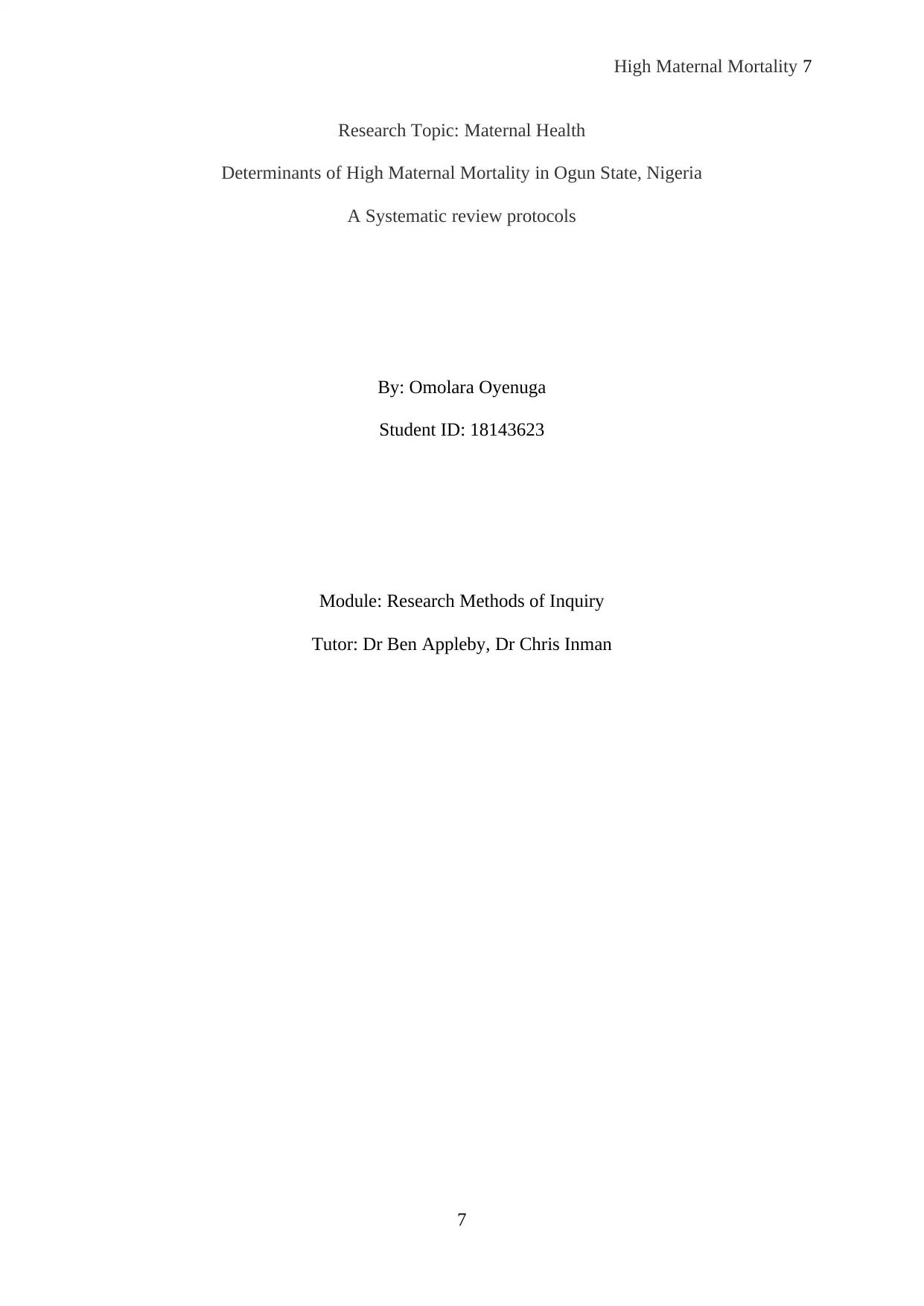
High Maternal Mortality 7
Research Topic: Maternal Health
Determinants of High Maternal Mortality in Ogun State, Nigeria
A Systematic review protocols
By: Omolara Oyenuga
Student ID: 18143623
Module: Research Methods of Inquiry
Tutor: Dr Ben Appleby, Dr Chris Inman
7
Research Topic: Maternal Health
Determinants of High Maternal Mortality in Ogun State, Nigeria
A Systematic review protocols
By: Omolara Oyenuga
Student ID: 18143623
Module: Research Methods of Inquiry
Tutor: Dr Ben Appleby, Dr Chris Inman
7
Paraphrase This Document
Need a fresh take? Get an instant paraphrase of this document with our AI Paraphraser
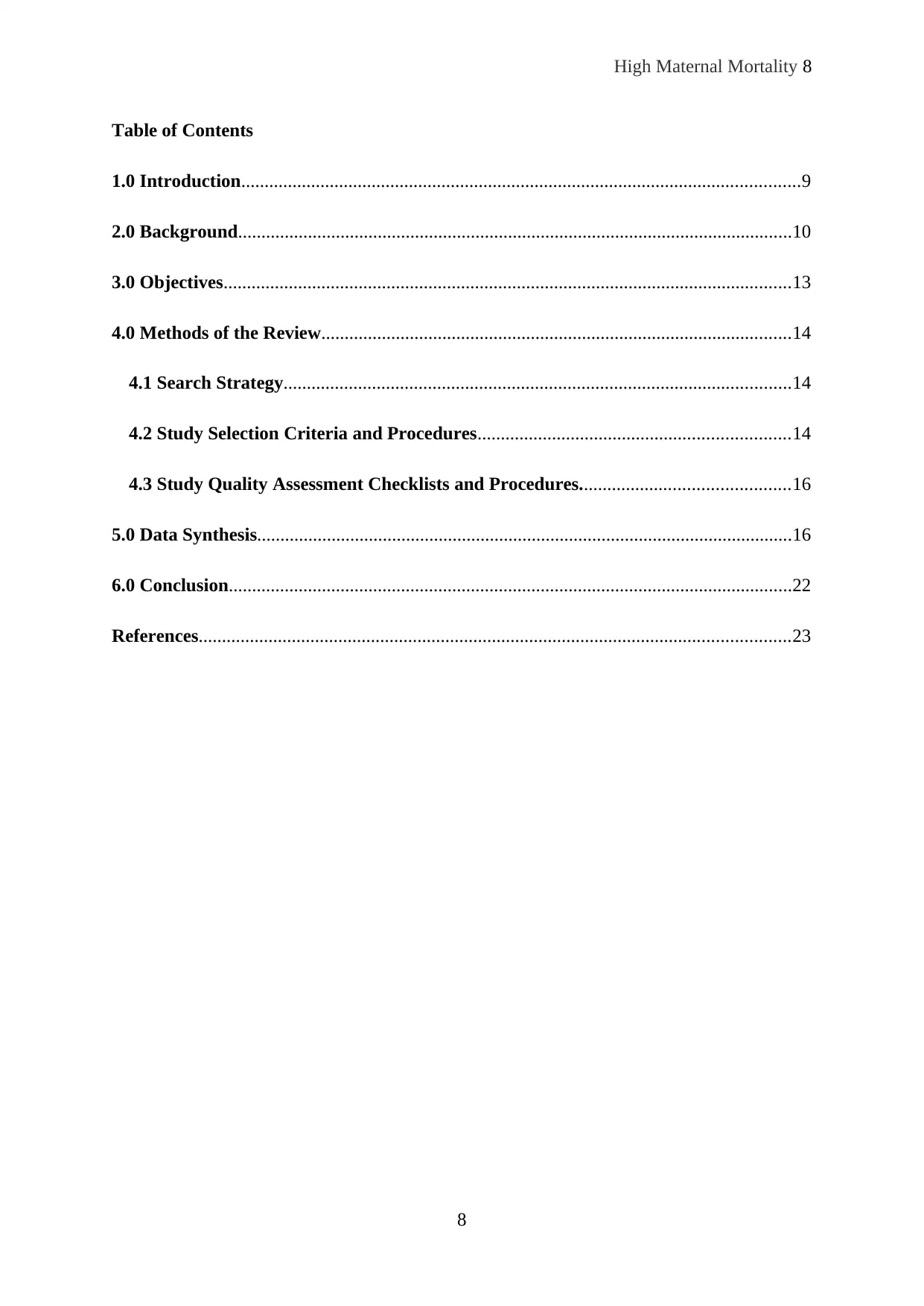
High Maternal Mortality 8
Table of Contents
1.0 Introduction........................................................................................................................9
2.0 Background.......................................................................................................................10
3.0 Objectives..........................................................................................................................13
4.0 Methods of the Review.....................................................................................................14
4.1 Search Strategy.............................................................................................................14
4.2 Study Selection Criteria and Procedures...................................................................14
4.3 Study Quality Assessment Checklists and Procedures.............................................16
5.0 Data Synthesis...................................................................................................................16
6.0 Conclusion.........................................................................................................................22
References...............................................................................................................................23
8
Table of Contents
1.0 Introduction........................................................................................................................9
2.0 Background.......................................................................................................................10
3.0 Objectives..........................................................................................................................13
4.0 Methods of the Review.....................................................................................................14
4.1 Search Strategy.............................................................................................................14
4.2 Study Selection Criteria and Procedures...................................................................14
4.3 Study Quality Assessment Checklists and Procedures.............................................16
5.0 Data Synthesis...................................................................................................................16
6.0 Conclusion.........................................................................................................................22
References...............................................................................................................................23
8
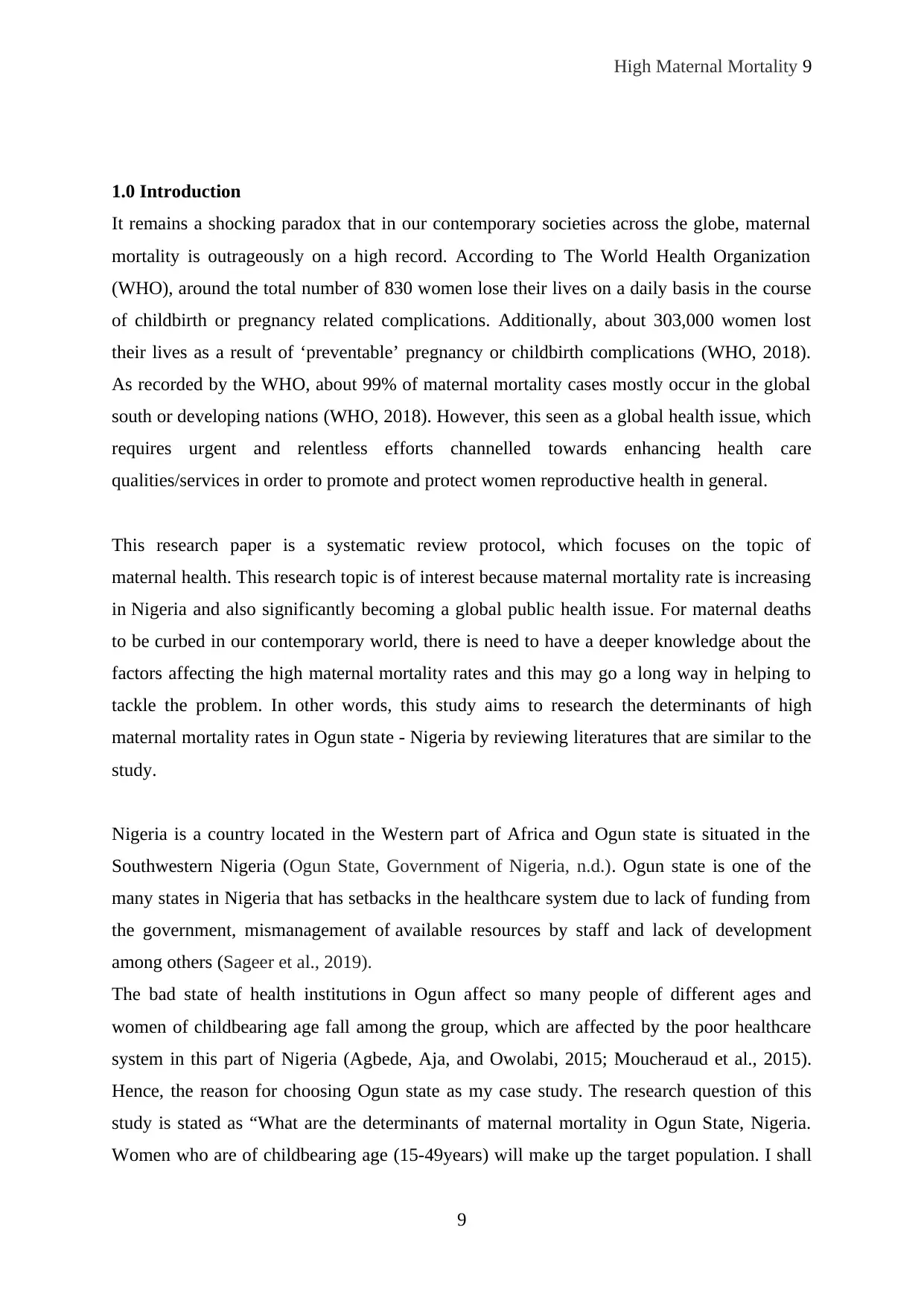
High Maternal Mortality 9
1.0 Introduction
It remains a shocking paradox that in our contemporary societies across the globe, maternal
mortality is outrageously on a high record. According to The World Health Organization
(WHO), around the total number of 830 women lose their lives on a daily basis in the course
of childbirth or pregnancy related complications. Additionally, about 303,000 women lost
their lives as a result of ‘preventable’ pregnancy or childbirth complications (WHO, 2018).
As recorded by the WHO, about 99% of maternal mortality cases mostly occur in the global
south or developing nations (WHO, 2018). However, this seen as a global health issue, which
requires urgent and relentless efforts channelled towards enhancing health care
qualities/services in order to promote and protect women reproductive health in general.
This research paper is a systematic review protocol, which focuses on the topic of
maternal health. This research topic is of interest because maternal mortality rate is increasing
in Nigeria and also significantly becoming a global public health issue. For maternal deaths
to be curbed in our contemporary world, there is need to have a deeper knowledge about the
factors affecting the high maternal mortality rates and this may go a long way in helping to
tackle the problem. In other words, this study aims to research the determinants of high
maternal mortality rates in Ogun state - Nigeria by reviewing literatures that are similar to the
study.
Nigeria is a country located in the Western part of Africa and Ogun state is situated in the
Southwestern Nigeria (Ogun State, Government of Nigeria, n.d.). Ogun state is one of the
many states in Nigeria that has setbacks in the healthcare system due to lack of funding from
the government, mismanagement of available resources by staff and lack of development
among others (Sageer et al., 2019).
The bad state of health institutions in Ogun affect so many people of different ages and
women of childbearing age fall among the group, which are affected by the poor healthcare
system in this part of Nigeria (Agbede, Aja, and Owolabi, 2015; Moucheraud et al., 2015).
Hence, the reason for choosing Ogun state as my case study. The research question of this
study is stated as “What are the determinants of maternal mortality in Ogun State, Nigeria.
Women who are of childbearing age (15-49years) will make up the target population. I shall
9
1.0 Introduction
It remains a shocking paradox that in our contemporary societies across the globe, maternal
mortality is outrageously on a high record. According to The World Health Organization
(WHO), around the total number of 830 women lose their lives on a daily basis in the course
of childbirth or pregnancy related complications. Additionally, about 303,000 women lost
their lives as a result of ‘preventable’ pregnancy or childbirth complications (WHO, 2018).
As recorded by the WHO, about 99% of maternal mortality cases mostly occur in the global
south or developing nations (WHO, 2018). However, this seen as a global health issue, which
requires urgent and relentless efforts channelled towards enhancing health care
qualities/services in order to promote and protect women reproductive health in general.
This research paper is a systematic review protocol, which focuses on the topic of
maternal health. This research topic is of interest because maternal mortality rate is increasing
in Nigeria and also significantly becoming a global public health issue. For maternal deaths
to be curbed in our contemporary world, there is need to have a deeper knowledge about the
factors affecting the high maternal mortality rates and this may go a long way in helping to
tackle the problem. In other words, this study aims to research the determinants of high
maternal mortality rates in Ogun state - Nigeria by reviewing literatures that are similar to the
study.
Nigeria is a country located in the Western part of Africa and Ogun state is situated in the
Southwestern Nigeria (Ogun State, Government of Nigeria, n.d.). Ogun state is one of the
many states in Nigeria that has setbacks in the healthcare system due to lack of funding from
the government, mismanagement of available resources by staff and lack of development
among others (Sageer et al., 2019).
The bad state of health institutions in Ogun affect so many people of different ages and
women of childbearing age fall among the group, which are affected by the poor healthcare
system in this part of Nigeria (Agbede, Aja, and Owolabi, 2015; Moucheraud et al., 2015).
Hence, the reason for choosing Ogun state as my case study. The research question of this
study is stated as “What are the determinants of maternal mortality in Ogun State, Nigeria.
Women who are of childbearing age (15-49years) will make up the target population. I shall
9
⊘ This is a preview!⊘
Do you want full access?
Subscribe today to unlock all pages.

Trusted by 1+ million students worldwide
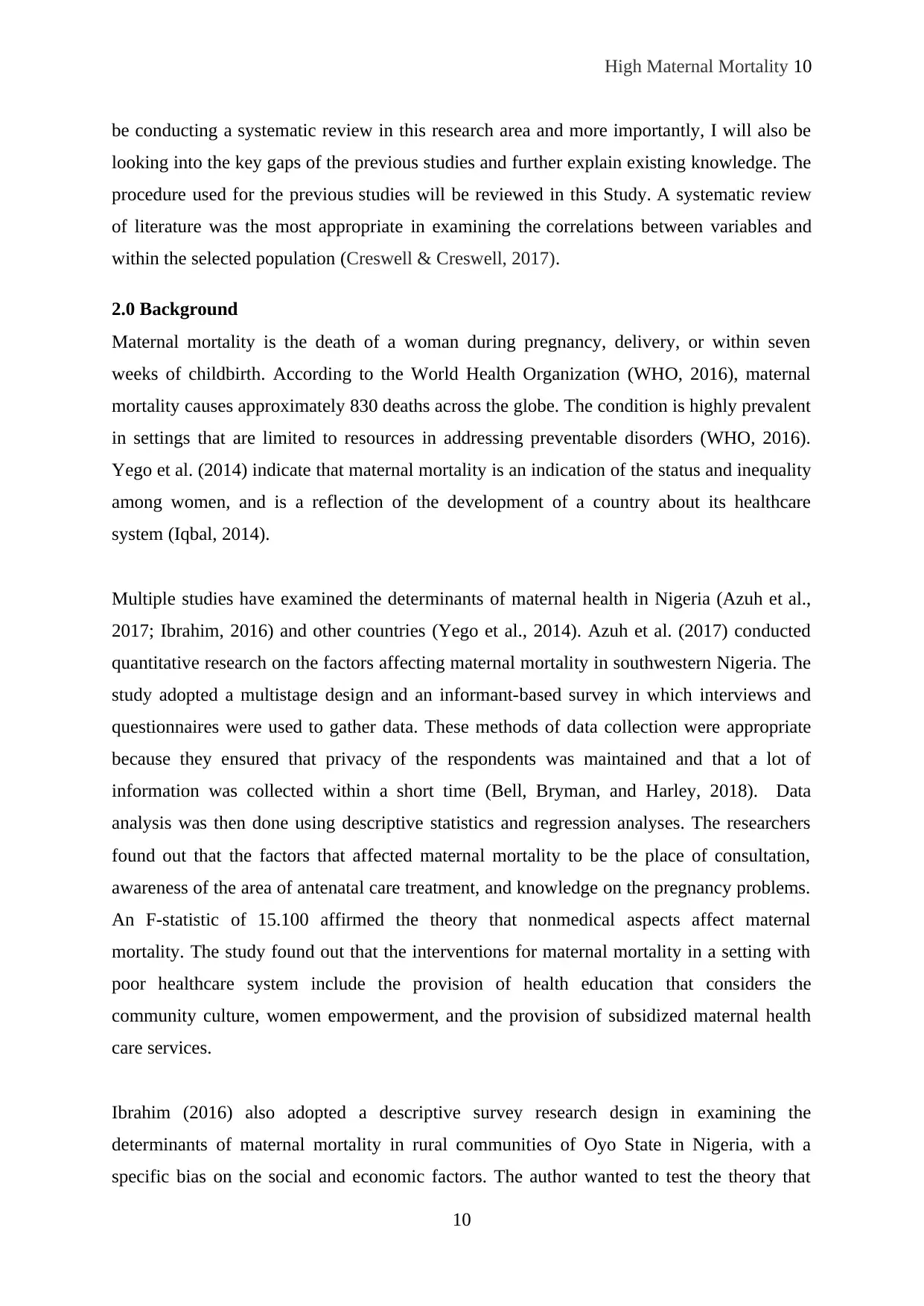
High Maternal Mortality 10
be conducting a systematic review in this research area and more importantly, I will also be
looking into the key gaps of the previous studies and further explain existing knowledge. The
procedure used for the previous studies will be reviewed in this Study. A systematic review
of literature was the most appropriate in examining the correlations between variables and
within the selected population (Creswell & Creswell, 2017).
2.0 Background
Maternal mortality is the death of a woman during pregnancy, delivery, or within seven
weeks of childbirth. According to the World Health Organization (WHO, 2016), maternal
mortality causes approximately 830 deaths across the globe. The condition is highly prevalent
in settings that are limited to resources in addressing preventable disorders (WHO, 2016).
Yego et al. (2014) indicate that maternal mortality is an indication of the status and inequality
among women, and is a reflection of the development of a country about its healthcare
system (Iqbal, 2014).
Multiple studies have examined the determinants of maternal health in Nigeria (Azuh et al.,
2017; Ibrahim, 2016) and other countries (Yego et al., 2014). Azuh et al. (2017) conducted
quantitative research on the factors affecting maternal mortality in southwestern Nigeria. The
study adopted a multistage design and an informant-based survey in which interviews and
questionnaires were used to gather data. These methods of data collection were appropriate
because they ensured that privacy of the respondents was maintained and that a lot of
information was collected within a short time (Bell, Bryman, and Harley, 2018). Data
analysis was then done using descriptive statistics and regression analyses. The researchers
found out that the factors that affected maternal mortality to be the place of consultation,
awareness of the area of antenatal care treatment, and knowledge on the pregnancy problems.
An F-statistic of 15.100 affirmed the theory that nonmedical aspects affect maternal
mortality. The study found out that the interventions for maternal mortality in a setting with
poor healthcare system include the provision of health education that considers the
community culture, women empowerment, and the provision of subsidized maternal health
care services.
Ibrahim (2016) also adopted a descriptive survey research design in examining the
determinants of maternal mortality in rural communities of Oyo State in Nigeria, with a
specific bias on the social and economic factors. The author wanted to test the theory that
10
be conducting a systematic review in this research area and more importantly, I will also be
looking into the key gaps of the previous studies and further explain existing knowledge. The
procedure used for the previous studies will be reviewed in this Study. A systematic review
of literature was the most appropriate in examining the correlations between variables and
within the selected population (Creswell & Creswell, 2017).
2.0 Background
Maternal mortality is the death of a woman during pregnancy, delivery, or within seven
weeks of childbirth. According to the World Health Organization (WHO, 2016), maternal
mortality causes approximately 830 deaths across the globe. The condition is highly prevalent
in settings that are limited to resources in addressing preventable disorders (WHO, 2016).
Yego et al. (2014) indicate that maternal mortality is an indication of the status and inequality
among women, and is a reflection of the development of a country about its healthcare
system (Iqbal, 2014).
Multiple studies have examined the determinants of maternal health in Nigeria (Azuh et al.,
2017; Ibrahim, 2016) and other countries (Yego et al., 2014). Azuh et al. (2017) conducted
quantitative research on the factors affecting maternal mortality in southwestern Nigeria. The
study adopted a multistage design and an informant-based survey in which interviews and
questionnaires were used to gather data. These methods of data collection were appropriate
because they ensured that privacy of the respondents was maintained and that a lot of
information was collected within a short time (Bell, Bryman, and Harley, 2018). Data
analysis was then done using descriptive statistics and regression analyses. The researchers
found out that the factors that affected maternal mortality to be the place of consultation,
awareness of the area of antenatal care treatment, and knowledge on the pregnancy problems.
An F-statistic of 15.100 affirmed the theory that nonmedical aspects affect maternal
mortality. The study found out that the interventions for maternal mortality in a setting with
poor healthcare system include the provision of health education that considers the
community culture, women empowerment, and the provision of subsidized maternal health
care services.
Ibrahim (2016) also adopted a descriptive survey research design in examining the
determinants of maternal mortality in rural communities of Oyo State in Nigeria, with a
specific bias on the social and economic factors. The author wanted to test the theory that
10
Paraphrase This Document
Need a fresh take? Get an instant paraphrase of this document with our AI Paraphraser
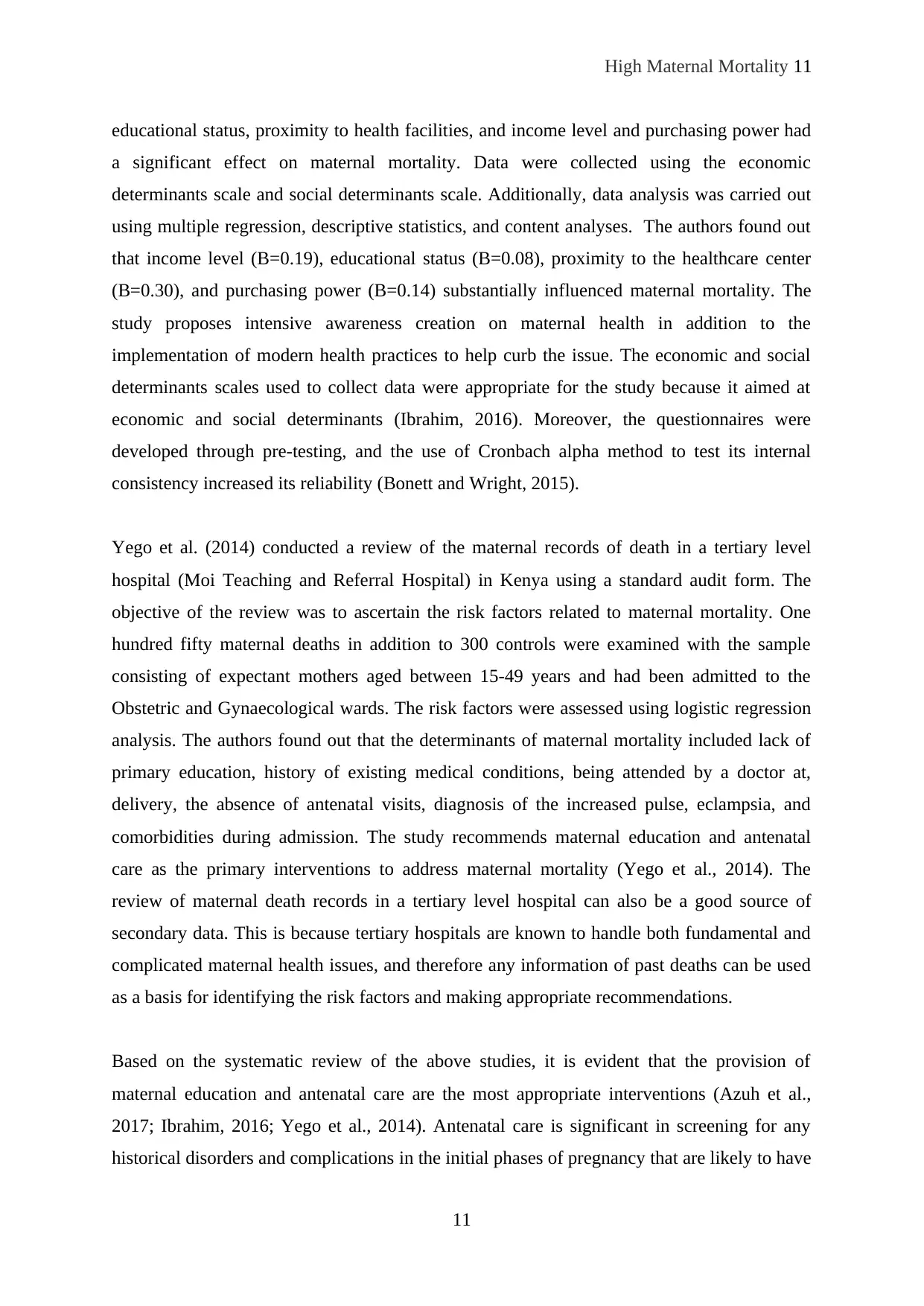
High Maternal Mortality 11
educational status, proximity to health facilities, and income level and purchasing power had
a significant effect on maternal mortality. Data were collected using the economic
determinants scale and social determinants scale. Additionally, data analysis was carried out
using multiple regression, descriptive statistics, and content analyses. The authors found out
that income level (B=0.19), educational status (B=0.08), proximity to the healthcare center
(B=0.30), and purchasing power (B=0.14) substantially influenced maternal mortality. The
study proposes intensive awareness creation on maternal health in addition to the
implementation of modern health practices to help curb the issue. The economic and social
determinants scales used to collect data were appropriate for the study because it aimed at
economic and social determinants (Ibrahim, 2016). Moreover, the questionnaires were
developed through pre-testing, and the use of Cronbach alpha method to test its internal
consistency increased its reliability (Bonett and Wright, 2015).
Yego et al. (2014) conducted a review of the maternal records of death in a tertiary level
hospital (Moi Teaching and Referral Hospital) in Kenya using a standard audit form. The
objective of the review was to ascertain the risk factors related to maternal mortality. One
hundred fifty maternal deaths in addition to 300 controls were examined with the sample
consisting of expectant mothers aged between 15-49 years and had been admitted to the
Obstetric and Gynaecological wards. The risk factors were assessed using logistic regression
analysis. The authors found out that the determinants of maternal mortality included lack of
primary education, history of existing medical conditions, being attended by a doctor at,
delivery, the absence of antenatal visits, diagnosis of the increased pulse, eclampsia, and
comorbidities during admission. The study recommends maternal education and antenatal
care as the primary interventions to address maternal mortality (Yego et al., 2014). The
review of maternal death records in a tertiary level hospital can also be a good source of
secondary data. This is because tertiary hospitals are known to handle both fundamental and
complicated maternal health issues, and therefore any information of past deaths can be used
as a basis for identifying the risk factors and making appropriate recommendations.
Based on the systematic review of the above studies, it is evident that the provision of
maternal education and antenatal care are the most appropriate interventions (Azuh et al.,
2017; Ibrahim, 2016; Yego et al., 2014). Antenatal care is significant in screening for any
historical disorders and complications in the initial phases of pregnancy that are likely to have
11
educational status, proximity to health facilities, and income level and purchasing power had
a significant effect on maternal mortality. Data were collected using the economic
determinants scale and social determinants scale. Additionally, data analysis was carried out
using multiple regression, descriptive statistics, and content analyses. The authors found out
that income level (B=0.19), educational status (B=0.08), proximity to the healthcare center
(B=0.30), and purchasing power (B=0.14) substantially influenced maternal mortality. The
study proposes intensive awareness creation on maternal health in addition to the
implementation of modern health practices to help curb the issue. The economic and social
determinants scales used to collect data were appropriate for the study because it aimed at
economic and social determinants (Ibrahim, 2016). Moreover, the questionnaires were
developed through pre-testing, and the use of Cronbach alpha method to test its internal
consistency increased its reliability (Bonett and Wright, 2015).
Yego et al. (2014) conducted a review of the maternal records of death in a tertiary level
hospital (Moi Teaching and Referral Hospital) in Kenya using a standard audit form. The
objective of the review was to ascertain the risk factors related to maternal mortality. One
hundred fifty maternal deaths in addition to 300 controls were examined with the sample
consisting of expectant mothers aged between 15-49 years and had been admitted to the
Obstetric and Gynaecological wards. The risk factors were assessed using logistic regression
analysis. The authors found out that the determinants of maternal mortality included lack of
primary education, history of existing medical conditions, being attended by a doctor at,
delivery, the absence of antenatal visits, diagnosis of the increased pulse, eclampsia, and
comorbidities during admission. The study recommends maternal education and antenatal
care as the primary interventions to address maternal mortality (Yego et al., 2014). The
review of maternal death records in a tertiary level hospital can also be a good source of
secondary data. This is because tertiary hospitals are known to handle both fundamental and
complicated maternal health issues, and therefore any information of past deaths can be used
as a basis for identifying the risk factors and making appropriate recommendations.
Based on the systematic review of the above studies, it is evident that the provision of
maternal education and antenatal care are the most appropriate interventions (Azuh et al.,
2017; Ibrahim, 2016; Yego et al., 2014). Antenatal care is significant in screening for any
historical disorders and complications in the initial phases of pregnancy that are likely to have
11
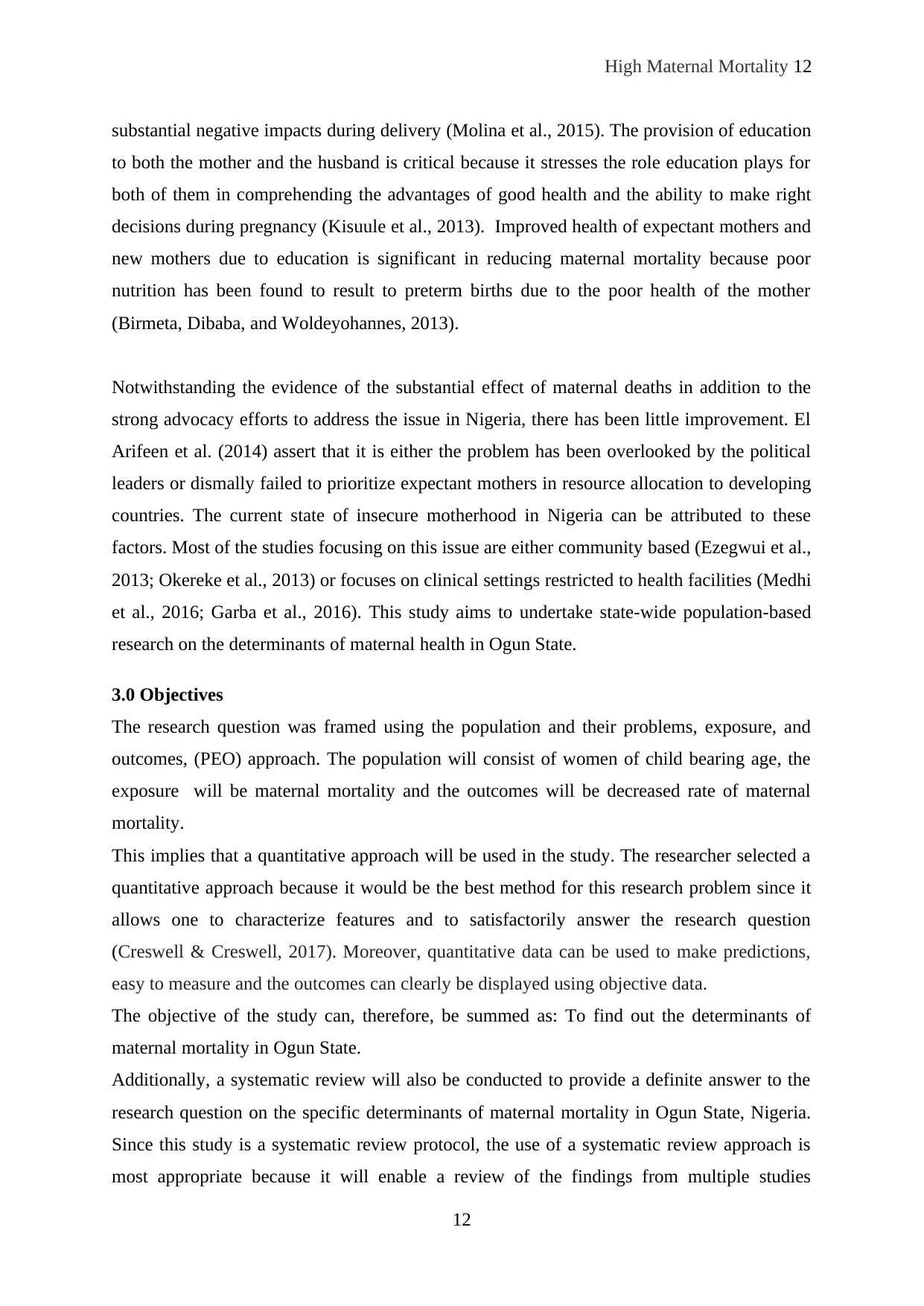
High Maternal Mortality 12
substantial negative impacts during delivery (Molina et al., 2015). The provision of education
to both the mother and the husband is critical because it stresses the role education plays for
both of them in comprehending the advantages of good health and the ability to make right
decisions during pregnancy (Kisuule et al., 2013). Improved health of expectant mothers and
new mothers due to education is significant in reducing maternal mortality because poor
nutrition has been found to result to preterm births due to the poor health of the mother
(Birmeta, Dibaba, and Woldeyohannes, 2013).
Notwithstanding the evidence of the substantial effect of maternal deaths in addition to the
strong advocacy efforts to address the issue in Nigeria, there has been little improvement. El
Arifeen et al. (2014) assert that it is either the problem has been overlooked by the political
leaders or dismally failed to prioritize expectant mothers in resource allocation to developing
countries. The current state of insecure motherhood in Nigeria can be attributed to these
factors. Most of the studies focusing on this issue are either community based (Ezegwui et al.,
2013; Okereke et al., 2013) or focuses on clinical settings restricted to health facilities (Medhi
et al., 2016; Garba et al., 2016). This study aims to undertake state-wide population-based
research on the determinants of maternal health in Ogun State.
3.0 Objectives
The research question was framed using the population and their problems, exposure, and
outcomes, (PEO) approach. The population will consist of women of child bearing age, the
exposure will be maternal mortality and the outcomes will be decreased rate of maternal
mortality.
This implies that a quantitative approach will be used in the study. The researcher selected a
quantitative approach because it would be the best method for this research problem since it
allows one to characterize features and to satisfactorily answer the research question
(Creswell & Creswell, 2017). Moreover, quantitative data can be used to make predictions,
easy to measure and the outcomes can clearly be displayed using objective data.
The objective of the study can, therefore, be summed as: To find out the determinants of
maternal mortality in Ogun State.
Additionally, a systematic review will also be conducted to provide a definite answer to the
research question on the specific determinants of maternal mortality in Ogun State, Nigeria.
Since this study is a systematic review protocol, the use of a systematic review approach is
most appropriate because it will enable a review of the findings from multiple studies
12
substantial negative impacts during delivery (Molina et al., 2015). The provision of education
to both the mother and the husband is critical because it stresses the role education plays for
both of them in comprehending the advantages of good health and the ability to make right
decisions during pregnancy (Kisuule et al., 2013). Improved health of expectant mothers and
new mothers due to education is significant in reducing maternal mortality because poor
nutrition has been found to result to preterm births due to the poor health of the mother
(Birmeta, Dibaba, and Woldeyohannes, 2013).
Notwithstanding the evidence of the substantial effect of maternal deaths in addition to the
strong advocacy efforts to address the issue in Nigeria, there has been little improvement. El
Arifeen et al. (2014) assert that it is either the problem has been overlooked by the political
leaders or dismally failed to prioritize expectant mothers in resource allocation to developing
countries. The current state of insecure motherhood in Nigeria can be attributed to these
factors. Most of the studies focusing on this issue are either community based (Ezegwui et al.,
2013; Okereke et al., 2013) or focuses on clinical settings restricted to health facilities (Medhi
et al., 2016; Garba et al., 2016). This study aims to undertake state-wide population-based
research on the determinants of maternal health in Ogun State.
3.0 Objectives
The research question was framed using the population and their problems, exposure, and
outcomes, (PEO) approach. The population will consist of women of child bearing age, the
exposure will be maternal mortality and the outcomes will be decreased rate of maternal
mortality.
This implies that a quantitative approach will be used in the study. The researcher selected a
quantitative approach because it would be the best method for this research problem since it
allows one to characterize features and to satisfactorily answer the research question
(Creswell & Creswell, 2017). Moreover, quantitative data can be used to make predictions,
easy to measure and the outcomes can clearly be displayed using objective data.
The objective of the study can, therefore, be summed as: To find out the determinants of
maternal mortality in Ogun State.
Additionally, a systematic review will also be conducted to provide a definite answer to the
research question on the specific determinants of maternal mortality in Ogun State, Nigeria.
Since this study is a systematic review protocol, the use of a systematic review approach is
most appropriate because it will enable a review of the findings from multiple studies
12
⊘ This is a preview!⊘
Do you want full access?
Subscribe today to unlock all pages.

Trusted by 1+ million students worldwide
1 out of 26
Related Documents
Your All-in-One AI-Powered Toolkit for Academic Success.
+13062052269
info@desklib.com
Available 24*7 on WhatsApp / Email
![[object Object]](/_next/static/media/star-bottom.7253800d.svg)
Unlock your academic potential
Copyright © 2020–2025 A2Z Services. All Rights Reserved. Developed and managed by ZUCOL.





